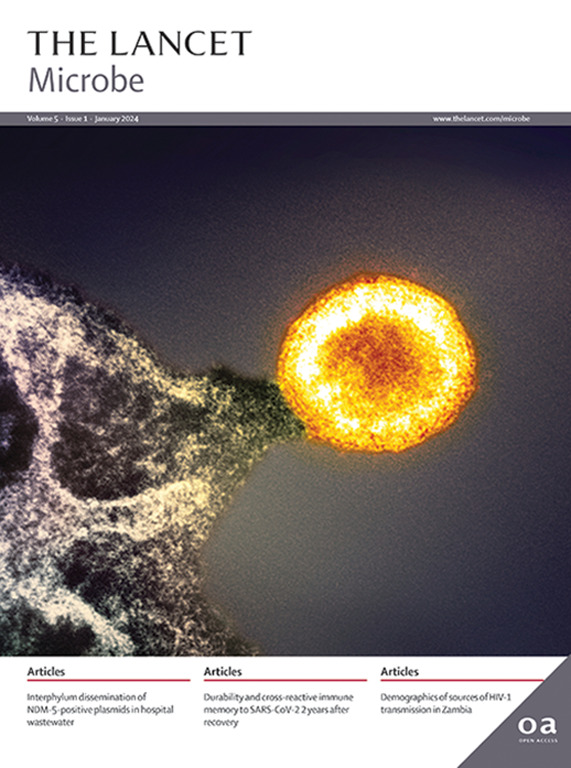Blood RNA biomarkers and C-reactive protein for triage of adult patients with tuberculosis lymphadenitis and pericarditis in South Africa: a single-centre, prospective, observational, diagnostic accuracy study
IF 20.4
1区 生物学
Q1 INFECTIOUS DISEASES
引用次数: 0
Abstract
Background
Data on the diagnostic accuracy of blood RNA biomarker signatures for extrapulmonary tuberculosis are scarce. We aimed to address this question among people investigated for tuberculosis lymphadenitis and tuberculosis pericarditis.
Methods
This prospective, observational, diagnostic accuracy study was done at a tertiary hospital in Cape Town, South Africa. We enrolled consecutive symptomatic adults (aged 18 years or older) with presumptive tuberculosis lymphadenitis (Jan 25, 2017, to Oct 9, 2019) or tuberculosis pericarditis (Nov 24, 2016, to Oct 28, 2019). We used microbiological testing of samples from the site of disease as the reference standard. We evaluated the diagnostic accuracy of seven previously reported blood RNA signatures by area under the receiver operating characteristic curve (AUROC) and sensitivity and specificity at prespecified thresholds using two SDs above the mean of a healthy reference control group, benchmarked against blood C-reactive protein and WHO target product profile for a tuberculosis triage test. Decision curve analysis was used to evaluate clinical utility of the best-performing blood RNA signature and C-reactive protein.
Findings
The pooled cohort included 440 individuals, 374 of whom (275 with lymphadenitis and 99 with pericarditis) had at least one microbiological test from the site of disease, blood C-reactive protein, and RNA measurements available and were included in the analysis. 181 (48%) participants were female and 193 (52%) were male. The diagnostic accuracy of blood RNA signatures was similar across patients with lymphadenitis and pericarditis. In pooled analysis of both cohorts, all RNA signatures had similar discrimination, with AUROC point estimates ranging from 0·77 (95% CI 0·72–0·82) to 0·82 (0·77–0·86), and greater than that of C-reactive protein (0·61 [0·56–0·67]). The best-performing signature (Roe3) did not meet the WHO target product profile benchmark for a triage test. At the prespecified threshold, Roe3 had 78% (95% CI 72–83) sensitivity and 69% (62–75) specificity; C-reactive protein at a threshold of 10 mg/L had 83% (77–87) sensitivity and 35% (29–43) specificity. In this setting, decision curve analysis showed that Roe3 offered greater net benefit than other approaches for services aiming to reduce the number needed to investigate with confirmatory testing to fewer than four to identify each individual with tuberculosis.
Interpretation
Our results suggest RNA biomarkers show better accuracy and clinical utility than C-reactive protein to trigger confirmatory tuberculosis testing in patients with tuberculosis lymphadenitis and tuberculosis pericarditis, but still fall short of the WHO target product profile for tuberculosis triage tests.
Funding
South African Medical Research Council, European and Developing Countries Clinical Trials Partnership 2, National Institutes of Health/National Institute of Allergy and Infectious Diseases, Wellcome Trust, National Institute for Health and Care Research, and Royal College of Physicians.
血液RNA生物标志物和c反应蛋白用于南非成年结核性淋巴结炎和心包炎患者的分类:一项单中心、前瞻性、观察性、诊断准确性研究
背景:关于血液RNA生物标志物特征对肺外结核的诊断准确性的数据很少。我们的目的是在调查结核性淋巴结炎和结核性心包炎的人群中解决这个问题。方法:这项前瞻性、观察性、诊断准确性的研究在南非开普敦的一家三级医院进行。我们招募了连续的有症状的成年人(18岁或以上),推定为结核性淋巴结炎(2017年1月25日至2019年10月9日)或结核性心包炎(2016年11月24日至2019年10月28日)。我们以疾病现场样品的微生物检测作为参考标准。我们通过受试者工作特征曲线下面积(AUROC)评估了先前报道的7种血液RNA特征的诊断准确性,并使用高于健康参照对照组平均值的两个SDs评估了预先设定阈值的敏感性和特异性,以血液c反应蛋白和WHO结核病分诊试验的目标产品概况为基准。决策曲线分析用于评估最佳表现的血液RNA标记和c反应蛋白的临床效用。结果:合并队列包括440名个体,其中374人(275名淋巴结炎患者和99名心包炎患者)至少有一项来自疾病部位的微生物检测、血液c反应蛋白和RNA测量,并被纳入分析。其中女性181人(48%),男性193人(52%)。血液RNA标记的诊断准确性在淋巴结炎和心包炎患者中相似。在两个队列的汇总分析中,所有RNA特征都具有相似的区别,AUROC点估计范围为0.77 (95% CI 0.72 - 0.82)至0.82 (95% CI 0.77 - 0.86),且大于c反应蛋白(0.61[0.56 - 0.67])。表现最好的签名(Roe3)未达到世卫组织分诊检测的目标产品概况基准。在预先设定的阈值下,Roe3的敏感性为78% (95% CI 72-83),特异性为69% (62-75);c反应蛋白阈值为10 mg/L时,敏感性为83%(77-87),特异性为35%(29-43)。在这种情况下,决策曲线分析表明,与其他方法相比,Roe3提供了更大的净效益,其目的是将需要进行确认性检测的调查人数减少到4人以下,以确定每个结核病患者。解释:我们的研究结果表明,在对结核性淋巴结炎和结核性心包炎患者进行确证结核检测时,RNA生物标志物比c反应蛋白具有更好的准确性和临床实用性,但仍未达到WHO结核病分诊检测的目标产品要求。资助:南非医学研究理事会、欧洲和发展中国家临床试验伙伴关系2、国家卫生研究院/国家过敏和传染病研究所、威康信托基金、国家卫生和保健研究所和皇家医师学院。
本文章由计算机程序翻译,如有差异,请以英文原文为准。
求助全文
约1分钟内获得全文
求助全文
来源期刊

Lancet Microbe
Multiple-
CiteScore
27.20
自引率
0.80%
发文量
278
审稿时长
6 weeks
期刊介绍:
The Lancet Microbe is a gold open access journal committed to publishing content relevant to clinical microbiologists worldwide, with a focus on studies that advance clinical understanding, challenge the status quo, and advocate change in health policy.
 求助内容:
求助内容: 应助结果提醒方式:
应助结果提醒方式:


